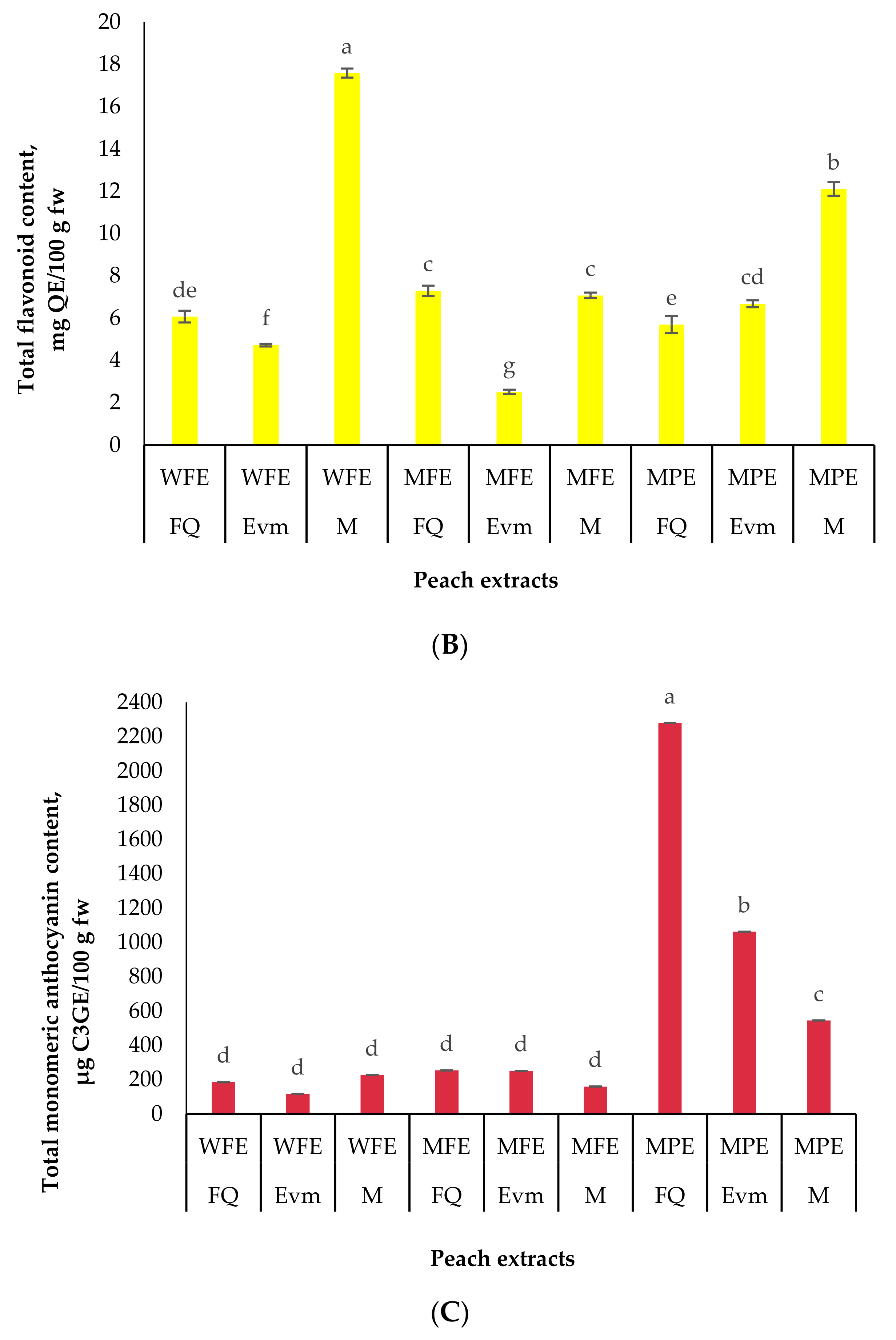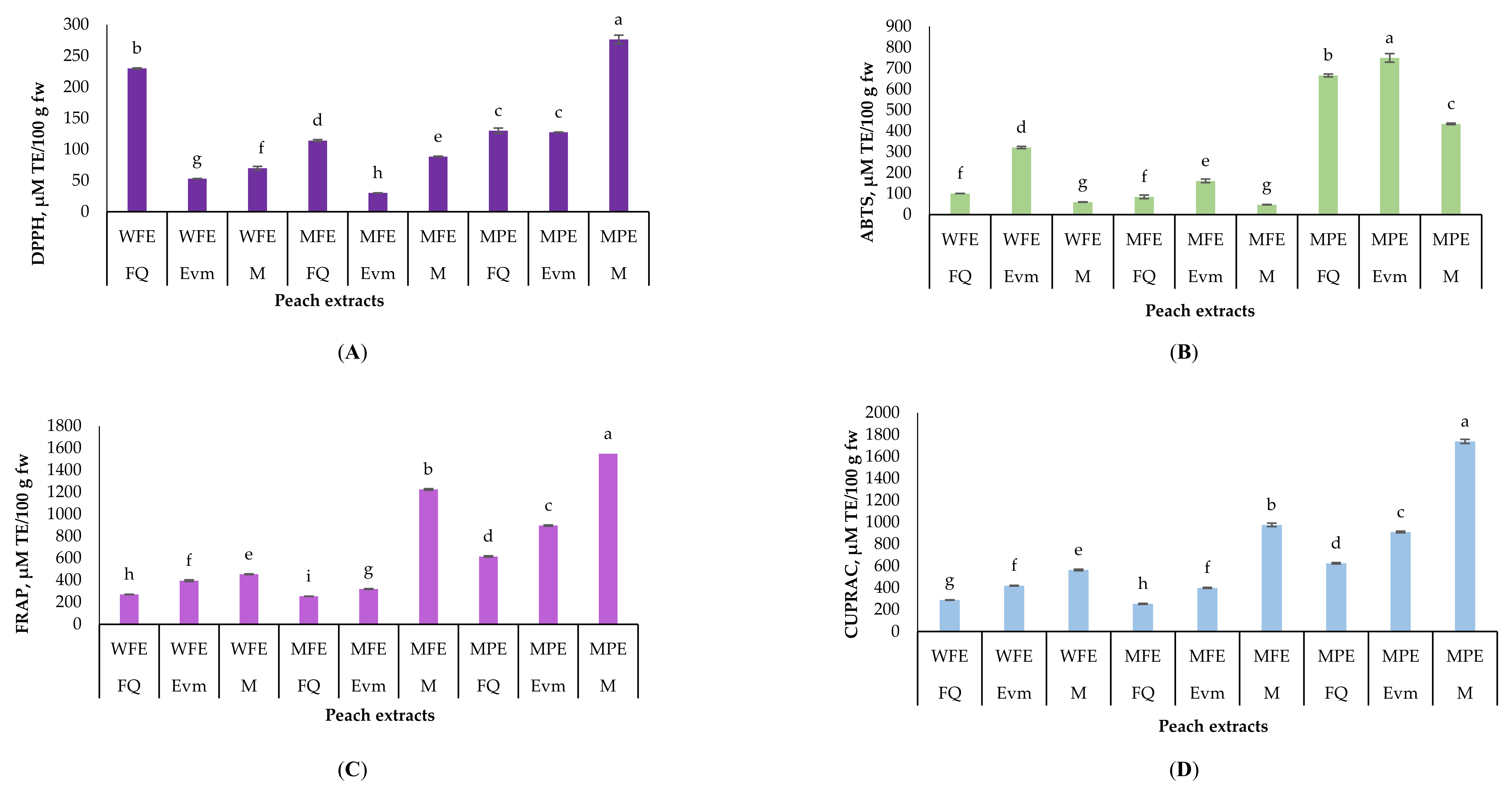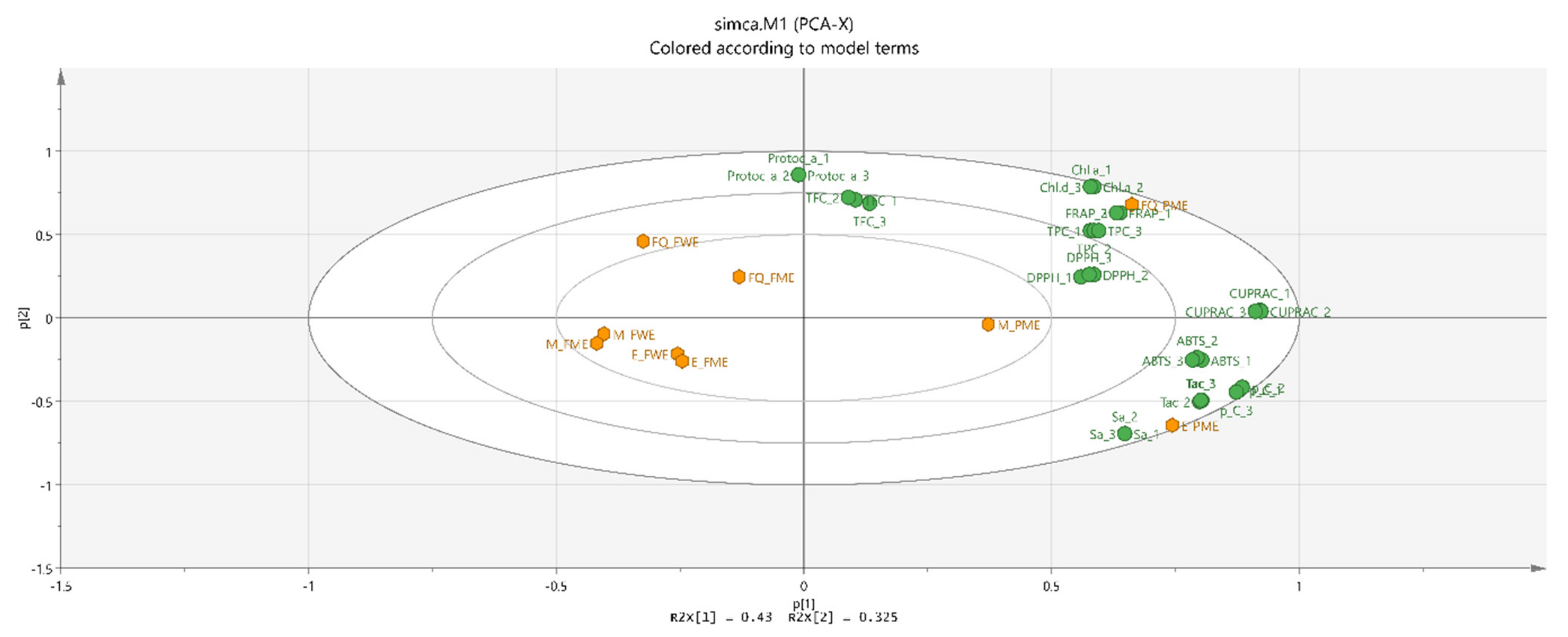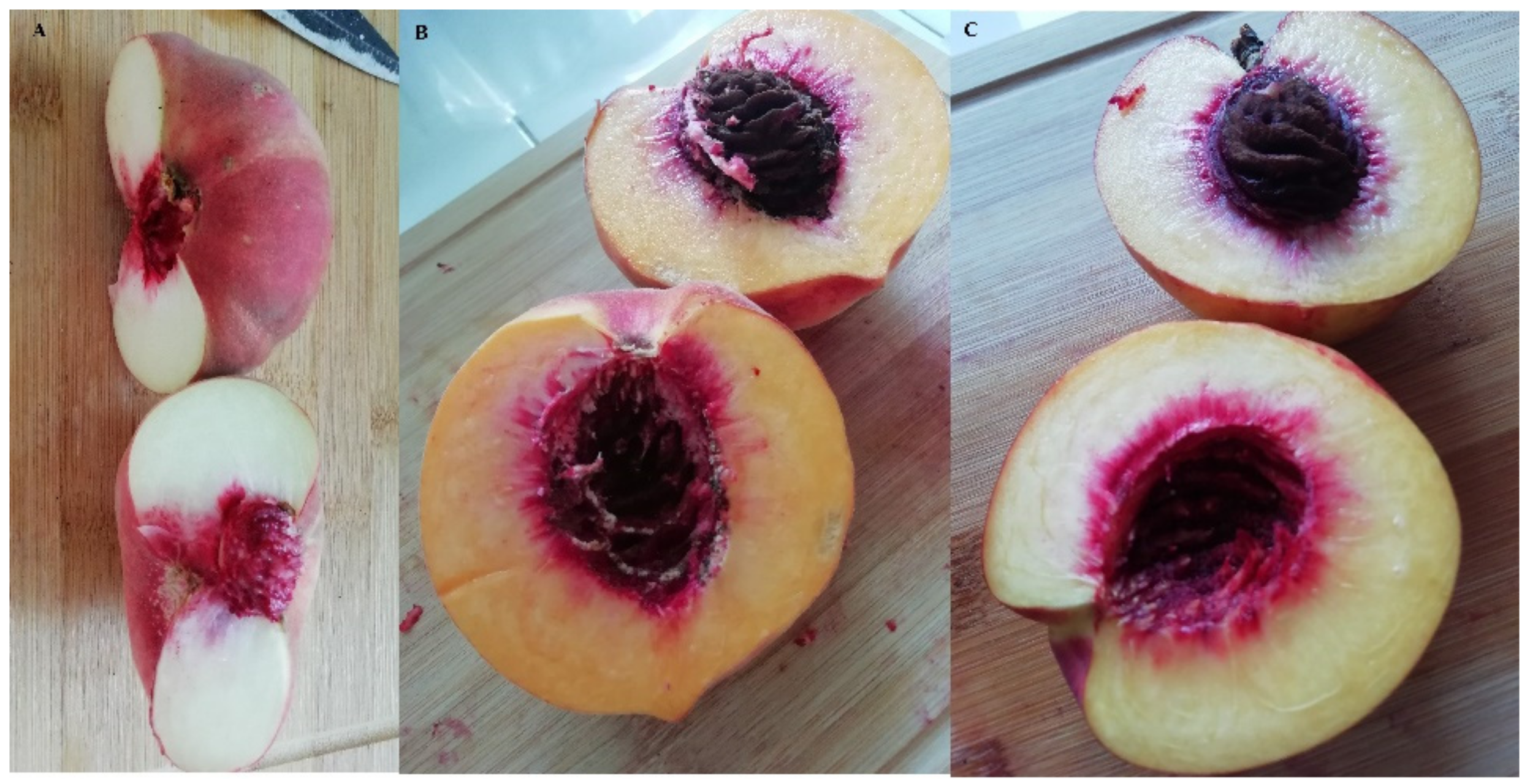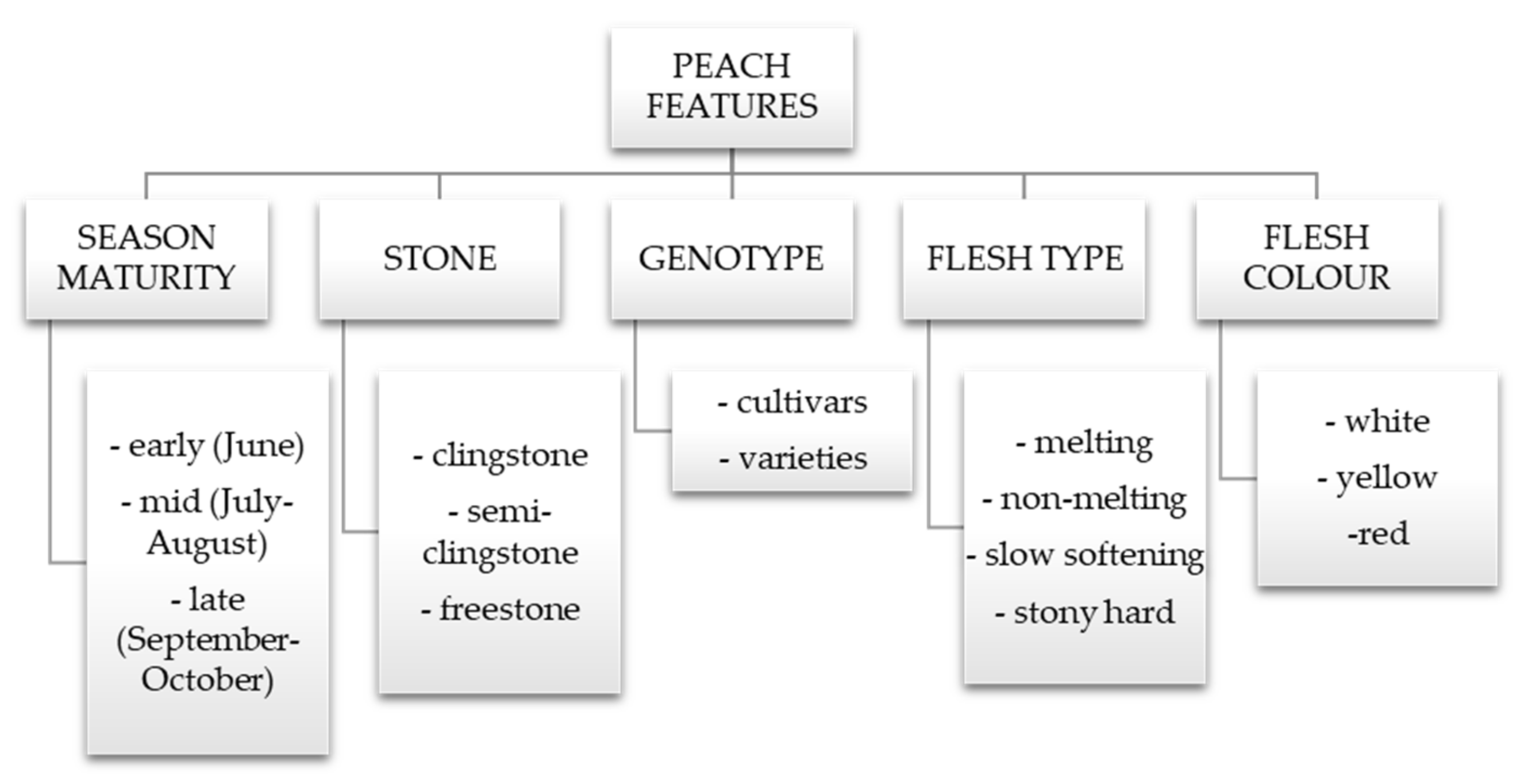2.1. Fruit Characteristics
Different physicochemical parameters were evaluated, i.e., fruit and pit weight, firmness, content of soluble solids, dry matter, ash, pH and titratable acidity, in the pre-sent study (
Table 2). The average fruit weight ranged from 185.63 to 221.88 g, wherein the heaviest fruits were those of the “Evmolpiya” variety. The fruit weight was considered as highly dependent on the harvest time, cultivar, fruit load, and on climatic and agricultural conditions [
29,
30]. In general, the later ripening peach varieties had heavier fruits than those harvested earlier and vice versa [
31], which is in agreement with the currently established. The lightest pit was weighted for “Flat Queen”. The stones of “Evmolpiya” and “Morsiani 90” did not differ statistically. In this regard, the stone mass was not in a clear relationship with the fruit weight, and could be assumed as specific for the variety, as already reported by Nowicka et al. [
17].
Firmness and fruit quality are strongly linked to each other. Firmness can be affected by cell wall strength [
32]. Regarding the firmness and dry matter, “Morsiani 90” dis-played the highest values—5.75 kg/cm
2 and 20.72%. Higher firmness means greater transport stability and longer life after harvest [
33]. The values were a little bit higher than the results reported by Aubert and Chalot [
34] who found a variation of dry matter content in 14 cultivars in the range from 10.5 to 18.0%. The ash content is reported as dependent on the growing conditions, in addition to the variety itself, which includes climatic influences [
35]. In this study, it varied from 0.68 to 1.36% for “Evmolpiya” and “Morsiani 90. The total soluble solids were 14.44 (“Flat Queen”), 14.50 (“Evmolpiya”), and 13.54% (“Morsiani 90”). The TSS content in peach fruits was higher compared to the results reported by other researchers [
34]. Acid pH was measured for all varieties; the lowest was detected in “Morsiani 90”—3.51.
Varieties with the same flesh firmness like “Flat Queen” and “Evmolpiya” showed different pH and TA values, but similar TSS, which implies that not only the firmness, but also other chemical attributes should be taken into account to the maturity stage. The maturity index (MI) of the fruits was analyzed in this study (
Table 2) as an indicator of the relationship between total soluble solids content and acids, which is an important index of fruit flavor [
17]. The maturity index of “Flat Queen” was calculated to be 32.09, while other two varieties had 1/3 lower indices (22.31 and 23.34).
Burdon et al. [
36] suggests that dry matter can be a maturity indicator and sensory quality predictor, as it includes both soluble and insoluble solids. Results obtained in this study partly disagree with this theory since “Morsiani 90”, the variety with the highest dry matter content, did not show a higher TSS value, although it contained the most total carbohydrates.
Color assessment is an important analysis that could predict fruit maturity and ca-rotenoid content [
37,
38]. The use of a colorimeter in order to determine the CIELAB color attributes, guarantees objective measurements and better determination [
39,
40].
Table 3 is a visual presentation of the CIELAB skin and flesh color measurements data of the studied peach varieties. No statistically significant variations of the skin and flesh lightness was reported between varieties. The hue angle values corresponded to the reddish-orange color for the skin, and the yellow color for the flesh. The chroma (color saturation) varied significantly among samples (for both skin and flesh).
Based on the CIELAB results, the total color difference was calculated and the three varieties were compared to each other. ΔEskin of “Flat Queen” compared to “Evmolpiya”, and “Morsiani 90” was 19.11 and 10.44, resp. ΔEskin of the comparison between “Evmolpiya” and “Morsiani 90” resulted in a value of 25.14. ΔEflesh for the same pair of varieties was 34.86, 28.41 and 7.44, resp.
Flesh color aids in the explanation of some quality and nutritional variations in peaches and nectarines. It is usually associated with maturity, phenolic acid and carotenoid contents. Values of “a” and hue flesh parameters can be used to determine the maturity of yellow fleshed peaches. Color measurement is an excellent non-destructive way of ripeness prediction.
2.2. Mineral Composition
The mineral composition was assessed as well, and the results are presented in
Table 4. The total mineral content of the varieties varied from 683.42 to 2349.03 mg/kg fw. Potassium (K) is the main macronutrient found in peaches [
22,
41]. The potassium has positive effect on human health. The increased intake of this nutrient lowers blood pressure, reduces cardiovascular disease mortality, and prevents the progression of renal disease [
42]. Although the soil contains sufficient amounts of available potassium (
Table 1), the three varieties included in the study accumulated quite different amounts of the nutrient in the fruits. “Morsiani 90” showed the highest content of K (1978.34, mg/kg fw), followed by “Evmolpiya” (738.48 mg/kg fw). The content of potassium in the variety “Flat Queen” was 5.6 times lower compared to “Morsiani 90” (353.37 mg/kg fw). Manzoor at al. [
22] did not find considerable differences in the fruits of three peach varieties grown in Pakistan. The content of P was the same in the fruits of “Flat Queen” and “Morsiani 90” (300 mg/kg fw). The content of this element in “Evmolpiya” was 200 mg/kg fw. The highest K and Na content was found in “Morsiani 90” (1978.34, 300.00 and 55.92 mg/kg fw), while the lowest was found in “Flat Queen” (353.37 and 24.57 mg/kg body weight). Fe and Zn, as essential microelements, are unevenly distributed among the varieties, in the range from 0.44–0.62 to 0.32–1.18 mg/kg fw. Iron was the most abundant element in “Evmolpiya”, while Zn—in “Morsiani 90”. Both elements are important. Iron as an essential trace element and a core of red blood cells, a deficiency of which can cause anemia [
43], and zinc—as a coenzyme for over 200 enzymes involved in immunity, new cell growth, acid base regulation etc. [
44]. The analyzed varieties contained very small amounts of Ca, less than 0.13 mg Ca/kg fw. The content of magnesium was the highest in the nectarine variety “Morsiani 90” (11.84 mg mg/kg fw). The content of this element was almost 3 times lower in “Flat Queen” and 4 times lower in “Evmolpiya”. The soil contented considerable amounts of exchangeable Mg, which can be absorbed by plants; even this content was increased in the summer, i.e., near the maturity of fruits (
Table 1). Therefore, the differences in magnesium content are mainly due to variety peculiarity. The highest content of Mn (0.22 mg/kg fw) and Cu (0.89 mg/kg fw) was quantified in “Morsiani 90”. Pb and Cr were found in less than 0.10 mg/kg fw, in all studied varieties. “Flat Queen” displayed significantly higher content of nitrogen—9.80 g/kg fw than “Evmolpiya” (1.0 g/kg fw) and “Morsiani 90” (4.1 g/kg fw).
A similar element profile has been reported for numerous peach varieties [
41,
45,
46]. However, a variety-specific composition should be taken into account [
45]. Potassium intake has been positively associated with bone metabolism, lower blood pressure and reduced morbidity and mortality from cardiovascular disease [
46,
47]. Zinc, copper and manganese, on the other hand, are essential microelements for human enzymes metabo-lism [
48]. Manganese is one of the important essential elements, but it is required only in trace amounts to maintain proper carbohydrates metabolism, as well as an antioxidant in superoxide dismutase enzymes [
43]. Magnesium plays an important role in the stability of the nervous system, muscle contraction, as an activator of alkaline phosphatase, and can also be used as an alternative to calcium in the body [
49].
The Kjeldahl method was used to assess the nitrogen content. Values ranges from 1.0 to 9.8 g/kg fw, including small amounts of protein nitrogen.
2.3. Nutrient and Phytochemical Characteristics
Carbohydrates (especially fructose, sorbitol and glucose), lipids and vitamins, among others, are considered basic fruit components [
50].
Table 5 presents the results for the carbohydrates, total lipids, dietary fiber, carotenoids, and tocopherols of the late ripening peach varieties, as well as their calculated energy equivalence. Sucrose was the major sugar in all varieties, and its value was the highest in “Flat Queen”—4.21 g/100 g fw. According to Cirilli et al. [
51] sucrose is the predominant sugar in the peach mesocarp at maturity, accounting for approximately 40–85% of the total sugars content. Glucose and fructose (in variable ratios), represent approximately 10–25%, and sorbitol accounts for less than 10%. In the current case, the lowest level of sorbitol was detected in “Evmolpiya” (0.09 g/100 g fw), while the highest—in “Morsiani 90” (0.47 g/100 g fw), accounting for approximately 10% of total sugars. A small amount of fructose, and large amount of sorbitol were found in peaches suggesting the existence of an inhibitor or a weak enzyme activity in the metabolic process into fructose [
52]. Sorbitol is a typical translocating substance in all representatives of the Rosacea family (apples and peaches), that can be converted to fructose or glucose by NAD+-dependent sorbitol dehydrogenase and sorbitol oxidase, respectively [
51]. Fruits with low fructose:glucose ratio are reported to have higher fructokinase and lower neutral invertase capacities [
13], which is the case of the “Morsiani 90” variety with a ratio of 0.18. This variety should also have a lower ability to catalyze sucrose into fructose and glucose.
Glucose was the second sugar, in high amounts, in the investigated samples. Glucose was the most abundant in the “Evmolpiya” peaches (1.60/100 g fw), which were also rich in fructose (0.95/100 g fw), and together with glucose brought the highest value of reducing sugars in this variety (6.19/100 g fw). Contrary to the statement of Nowicka et al. [
17], the glucose content was higher than that of fructose in all three peach varieties. Robertson and Meredith [
53] suggested that low-quality peaches contain lower fructose and higher sorbitol and glucose compared to high-quality peaches.
The total sugar value varies from 4.97 to 6.19/100 g fw, which coincides well with the results reported by other investigators (4.6–9.6%) [
41,
54]. Ninety-four traditional Spanish (mostly non-melting flesh types) varieties had similar values, where the total sugar con-tent varied from 63 to 136 g/kg FW (Suc 35–98, Glc 4–15, Fru 2–14, and Sor 2–35) [
55]. The highest values of total carbohydrates were found in the “Morsiani 90” peach—16 g/100 g fw. More than 55% of the total carbohydrates content in the “Flat Queen” variety was due to the reducing sugars, and below 30% was occupied by sucrose, as dominating sugar. The sucrose/glucose ratio in all three varieties was above 2.3 and reached a maximum of 5.47 for “Flat Queen”. This fact clearly indicated that sucrose is mainly responsible for the sweetness of these peaches. Sugars also affect mouth-feel attributes and aroma perception. Sucrose and sorbitol are highly correlated with the overall taste and aroma of fruits [
51]. For all three peach varieties, the glucose/fructose ratio was 1.8, which coincides with a previous report for peach varieties grown in Bulgaria [
41].
The perception of taste may be affected by many factors. Several indices were used to characterize peach fruit quality. Sweetness (SI) and total sweetness indices (TSI) are good indicators of the content of sucrose, glucose and fructose in the fruit (
Table 5). Each carbohydrate contributes differently in the calculation of the index with fructose having the highest coefficient. The variety with the highest TSS, has the highest SI and TSI as well, which corresponds to the carbohydrate content of the fruit, where glucose and fructose are predominant. All of the studied varieties can be considered sweet with a ratio of 1.1:1.3:1.0 (“Flat Queen”: “Evmolpiya”: “Morsiani 90”) corresponding to their size and TSS values. The “Evmolpiya” variety demonstrated the highest value of the SI (87.0) and TSI (62.8), while the lowest values were observed in the “Morsiani 90” variety (64.8 and 47.7, respectively). The sweetness intensity depends on the overall sugar amount, as well as on the specific sugar profile. However, the total acidity strongly affects the sweetness perception. Sweetness is mainly correlated with the sugars:acids ratio, and the overall organic acid concentration [
56,
57]. The soluble sugars and acid ratio determines the maturity and taste of the peach. The total sugars/total titratable acidity ratio of the three peach varieties “Flat Queen”, “Evmolpiya”, “Morsiani 90” varied from 12 to 21. In fruits, including peaches, this ratio is used to classify them as sour (MI: 5–7), sour–sweet (MI: 17–24), and sweet (MI: 31–98) [
58]. It can be concluded that the “Evmolpiya” variety was sour-sweet, while the other two varieties were semi-sweet. The currently established data coincided well with the values documented by other authors for European peach cultivars (13.24 (‘SB6A–35′peach) to 26.59 (“Royalvee “ peach)) [
17].
The lipid content in the analyzed peaches ranged from 0.61 g/100 fw to 0.46 g/100 g fw. The highest lipid content was detected in the “Evmolpiya” variety, which coincided with previously reported data for mid-ripening peach varieties [
41]. The total lipids in the cv. Redhaven peach [
59] were closer to the results reported for the “Flat Queen“ variety.
It is suggested that healthy individuals should consume at least 25–30 g of dietary fibers per day [
60]. Although the content of fiber in fresh fruits and vegetables is not high enough to satisfy this presumption, eating a 100 g of the investigated varieties will deliver approximately 3 g of TDF (about 10% of the minimally recommended daily intake) which could be used as an additional source of dietary fibers in the human diet. All three varieties have similar (statistically not different) amounts of TDF: around 3 g/100 g fw. The “Evmolpiya” variety had the lowest amount of SDF because of the higher IDF content. Similar results were reported for Israeli peaches (Prinus persica): 2.6–3.3 g/100 g [
61]. Lower amounts of dietary fiber, were reported (without specifying the variety) by Schakel et al. [
62]: around 2.0 g TDF/100 g, 1.21 g IDF/100 g and 0.80 g SDF/100 g fresh fruits. Contrary to the present results are the data for other Prunus persica L. varieties grown in Bulgaria: “Filina“, “Gergana“, “Ufo-4“, “July Lady“, and “Laskava“ [
41]. The amounts of SDF in “Flat Queen“ and “Morsiani 90“ were 30–50% higher than the others, which makes them a good source of soluble fibers. Due to their pronounced gelling behavior, these soluble polysaccharides could decrease the rate of gastric emptying and influence small intestinal transit time, which explains their hypoglycemic properties and beneficial effect on human constitution [
63].
Carotenoids are natural pigments that are responsible for the yellow, orange and red color of fruits, and some of them are important Vitamin A precursors [
45,
64]. In this context, a HPLC-DAD analysis of carotenoid content was conducted. It differed signifi-cantly among the investigated samples (
Table 5). Total carotenoid content varied from 501.72 µg/100 g fw (“Flat Queen”) to 3721.97 µg/100 g fw (“Evmolpiya”). Lycopene is not usually present in many fruit and vegetables [
65]. The lycopene ratio of the three varieties is 1:5.6:4 (“Flat Queen”:”Evmolpiya”:”Morsiani 90”). Its presence and higher content is proportionally linked to the red color of the fruit or vegetable, which is the case of the “Evmolpiya” variety. Lycopene’s red color is due to the many conjugated carbon double bonds, as it absorbs more visible spectrum compared to other carotenes [
66].
Lutein, which is usually found in fruit and vegetables, was the dominant carotenoid in the “Flat Queen” variety (292.99 µg/100 g fw), while β-carotene (2632.27 µg/100 g fw and 1224.55 µg/100 g fw, respectively) was the most abundant in the “Evmolpiya” and “Morsiani 90” samples. The white-flesh “Flat Queen” variety possessed the lowest quantity of β-carotene and the lowest total carotenoid content in comparison to the yel-low-fleshed “Evmolpiya” and “Morsiani 90” varieties. These trends were consistent with previously observed results in different cultivars of white- and yellow-flesh peaches and nectarines varieties. The reported content of β-carotene in the yellow-flesh nectarines and peaches was about ten to thirty times higher than in the white-flesh ones [
67].
Similarly, Aubert et al. [
68] estimated that β-carotene is predominant and accounted for 95−97% of the total carotenoid content (26 to 197 μg/100 g) in the yellow-flesh nec-tarines harvested at commercial ripeness stage. The content of β-carotene of nectarines and peaches, reported by Vicente et al. [
64], is approximately the same (150–160 μg/100 g). According to previous analyzes of the carotenoid content of early- and mid-ripening peaches and nectarines [
41,
45], the late-ripening varieties, contained about twice the amount of β-carotene. These findings prove the relationship between the maturity of peach fruit, the carotenoid content, and the colorimetric values of the “a” CIELAB measurement of the peach skin.
Among carotenoids, β-carotene is the main Vitamin A precursor, that is essential for the normal growth, reproduction, vision, and resistance to infection [
69]. Furthermore, some investigations have suggested the preventive benefits of β-carotene against lung and colorectal cancer [
70,
71,
72]. Total carotenoids are commonly high in yellow-fleshed peaches [
73], which explains the “Evmolpiya” values. The high variability of the total carotenoid content could be justified by a variety-based diversification of carotenoid synthesis as well as it could be due to the fact, that vividly colored fruit usually contain lycopene and β-carotene as main compounds [
74].
An analysis of the tocopherol content was conducted as well. Only α-tocopherol, which is the most biologically active form of vitamin E, was found (
Table 5). The “Mor-siani 90” variety had the highest concentration of α-tocopherol (395.75 µg/100 g fw), fol-lowed by “Evmolpiya” (258.27 µg/100 g fw) and “Flat Queen” (245.12 µg/100 g fw). δ-tocopherol and γ-tocopherol were not present in the samples. According to Vicente et al. [
64] the average content of α-tocopherol in peaches was 0.73 mg/100 g, which is about twice as high as in this study. Contrary to the results of Vicente et al. [
64], the α-tocopherol content in fresh peaches, established by Durst and Weaver [
75] was in the range from 1.42 ± 0.42 to 1.68 ± 0.24 mg/kg. The observed variations in the tocopherol content can be explained by the differences in the genotype of the varieties, maturity stage, environmental factors, etc.
Phenolic compounds are a diverse group of phytochemicals with complex chemical structure, degree of polymerization, and complicated interaction with other molecules. Hence, they are poorly bioavailable [
76]. In in vitro assays, different solvents have been tested and vast variation of the data exist [
77]. In addition, there is no single solvent that can extract all polyphenols [
78]. In the present study, two type of solvents were used—water and 80% aqueous methanol. Peel and whole fruit were analyzed for total phenolic, flavonoid and anthocyanin content, some individual phenolic acids, as well as antioxidant activity. The results are presented in
Figure 2. Two-way ANOVA was con-ducted in order to compare the main effects of variety and type of extract, as well as the interactive effect of both, on the total phenolic content. “Morsiani 90” and “Evmolpiya” peel extracts seemed to be the richest of TPC, resulting in 115.71, and 107.01 mg GAE/100 g fw, resp. The phenolic compounds in the other two extracts were less than 65 GAE/100 g fw. These results are comparable to the reported by Liu et al. [
79] and much less to the ones by Mokrani and Madani [
80].
Regarding the flavonoid content, “Morsiani 90” confirmed its higher concentrations. The whole fruit water extract had 17.59 mg QE/100 g fw, indicating the presence of fla-vonoid glycosides [
81]. In the methanolic peel extract, 12.11 mg QE/100 g fw were re-ported. Large variations between varieties are noted by Liu et al. [
79]: 17.76 ± 0.62 to 130.17 ± 0.81 mg RE/100 g fw (pulp), and 91.66 ± 1.05 to 299.86 ± 0.76 mg RE/100 g fw (peel).
Anthocyanins are often analyzed separately, even though they are part of the fla-vonoids group. They are reported as the main contributors to the coloration of fruits, being responsible for the majority of the red to blue color shades, and patterns in fruits [
82,
83]. Flesh color can indicate anthocyanin content [
73]. In this study, expectedly, the monomeric anthocyanins were concentrated in the peel of the fruits, resulting in 2279.33 (“Flat Queen“), 1061.67 (“Evmolpiya”), and 544.57 (“Morsiani 90”) µg C3GE/100 g fw. The content in the other extracts was under 250 µg C3GE/100 g fw, not statistically different between samples. These results are directly linked to the established CIELAB values (
Table 3), where the higher “a” values indicate red predominance of the color, and the lower “b” values show a blue shade.
The individual phenolic acids of the peach extracts were also evaluated, and the results are shown in
Table 6. The HPLC-DAD analysis revealed the presence of proto-catechuic, chlorogenic acid, p-coumaric, and sinapic acids. The estimated concentrations differed significantly between varieties and extracts of the same variety, as well. Chlorogenic acid was the predominant phenolic acid in all analyzed samples; the highest content was found in the peel extracts—315.10 (“Flat Queen“), 428.95 (“Evmolpiya”), and 986.95 (“Morsiani 90”) µg/g fw. This result is consistent with other studies related to the fact that chlorogenic acid is one of the main phenolic acids in different peach varieties [
45,
79,
84,
85,
86,
87]. This phenolic acid is associated with various valuable biological activities, such as anti-inflammatory [
88], anticancer [
72,
89], antioxidant [
90], antiepileptic, neuro-protective [
91], antidiabetic [
92], antimicrobial activity [
93] and others. The calculated total content ranged from 70.2 to 1067.9 µg/g fw.
The abundance of chlorogenic acid, in combination of an elevated flavonoid content in “Morsiani 90” affirms that higher phenolic content is usually present in the white and yellow flesh peaches/nectarines, and is not exclusive to red-flesh fruits.
Evaluation of the antioxidant potential of natural resources is of critical demand in respect of the modern human’s health lifestyle context. The antioxidant activity of the studied varieties extracts was assessed by four generally recognized methods. It is im-portant to use several methods in order to get the overall antioxidant potential of any food matrix. Two-way ANOVA was conducted to study the effect of variety and extract, as well as their combination. Overall, the peel extracts were the richest in antioxidants according to all four methods (
Figure 3). However, the antioxidant activity of fruits and vegetables determined by different antioxidant assays could give quite different results [
94,
95]. The highest Trolox equivalents per 100 g fw were detected in the peel extract of “Morsiani 90” followed by the methanolic extract of the whole fruit. Several research papers pointed a higher antioxidant activity potential of the peels compared to the cortex, mainly contributed to phenolic compounds [
41,
95]. According to the DPPH assay, the values varied from 30.09 to 276.28 µM/100 g fw. The peel extract of the “Morisani 90” variety possessed the highest antioxidant potential. The peel extracts had the strongest antioxidant response to the ABTS method, resulting in 433.89 (“Morsiani 90”), 665.61 (“Flat Queen“), and 749.67 (“Evmolpiya”) µM/100 g fw. Those results could be contrib-uted to the highest total monomeric anthocyanins content in the peels extracts of all three late season varieties. DPPH, FRAP and CUPRAC assays underlined that the “Morsiani 90” variety had the highest antioxidant potential.

